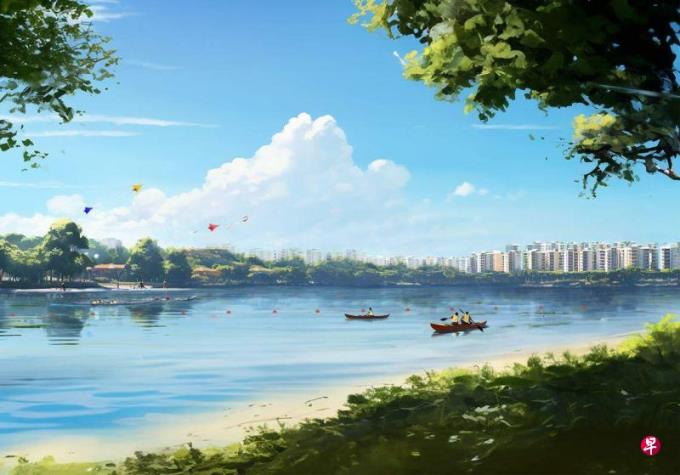
Singapore is a projectile country, and economic development is deeply restricted by land and population.However, by reclamation and absorbing foreign immigrants, Singapore's land area has expanded to 734 square kilometers today from 581 square kilometers in independence in 1965, and the population has increased from 1.88 million to 5.92 million.Singapore also promotes the first world from the Third World.
Foundation of land reclamation enables the government to plan the use of land more effectively.The land of Changi Airport, Jurong Island, and Binhai was given by the reclamation.The main reclamation projects are currently under construction, including the Changyong Land and Daji Port for the construction of the fifth passenger building.This will ensure that Singapore's airports and seaports will continue to be internationally leading internationally.
Xu Fangda, Minister of High -level and Senior Government Affairs of the Ministry of Finance, on Tuesday (December 26) to obtain a record of ships arrived in Hong Kong in the port of Singapore; at the celebration ceremony, the second section of Da Shigang has completed sevenCheng, the third stage of planning work has also begun.After the completion of 2040, the port of Dashi will become the world's largest fully automated container terminal. It can handle 65 million standard boxes each year, which is nearly doubled from the existing port throughput.
Singapore uses the advantages of the sea to reclamation to the sea, and has never stopped.On November 28, Li Zhisheng, Minister of Development of the National Development, announced that it was reclaimed on the East Coast to build a "Long Island" and built 800 hectares.Immediately afterwards, Jurong Group revealed to the media that it will launch a reclamation project in the Dashi North Basin in 2025, adding about 172 hectares of industrial land to the Dashi District, which is equivalent to 240 football fields.
TheLong Island reclamation plan is mainly to cope with the flood control projects of sea level rising. It takes decades of development. Related technology research starts from early 2024 for five years.On the other hand, the reclamation project of the Da Shibu Basin is expected to be completed in 2029.Jurong Group pointed out that this project is to meet future industrial land needs.Although different functions, they will further expand Singapore's land area.
Land is one of the elements of economic production.Insufficient land will limit the development of the industry, especially the large land consumption industry.Without the reclamation area of Jurong Island, Singapore's chemical industry may not have today's scale; if it was not for the first generation of leaders to take decisive measures to build airports in the vast reclamation area, there may be no international Changyi Airport today.Essence
Secondly, labor force is also another element of economic production.The labor market is tight, and enterprises will compete for employees and will push up their wages.Although technology can reduce dependence on labor, it cannot be completely replaced.Therefore, the size of the population is the same as the land, which is related to the economic competitiveness of the country.
Although the boat is good, the economic development requires a certain amount of volume to obtain the benefits of scale economy.In addition, the wave of protectionism swept the world, and the export -oriented economy of Singapore has been greatly impacted.Even if the domestic market in Singapore is small, it is still necessary to expand domestic demand to make up for the lack of foreign demand.A large domestic market allows local companies to have the opportunity to grow and accumulate competitiveness in challenging the international market.This means that the population base cannot be too small.
The development of Singapore is unlikely to get rid of the restrictions of land and population.However, the increase in land and population so far has eased the constraints of development and improved Singapore's comprehensive strength.But next, between the incremental increase of the land and the population, the restrictions of the population will face greater challenges.
At the National Day mass meeting in 2022, Premier Li Xianlong pointed out that sometimes Chinese people are worried about whether the land is enough, can the government build more houses, and whether the price of a house can be affordable.In fact, the government has completed research and planning, and has sufficient land to provide the next generation.He said: "Our question is whether there are enough babies to live in these houses."
The overall fertility rate of residents in Singapore has dropped straight, reaching a historical low in 2022.If foreign immigrants are not introduced, the total population will shrink.As of June 2023, Singapore's total population was 5.92 million, with 3.61 million citizens and 540,000 permanent residents.The remaining 1.77 million and non -residents account for 30%of the total population.
Premier Li reiterated at the Forbes Global President Forum in 2019 that Singapore's long -term goal is to reach two -thirds of Singaporean as the core labor team, and there are more babies produced by Singaporeans.He said: "To ensure our future, we must have the baby we produce, and there must be sufficient amount."
The decline in fertility rate and foreign immigrants are generally faced by developed economies in the world, and Singapore is no exception.Singapore has sufficient technology and funds to reclamation to the sea, but it is still looking for answers to improving the fertility rate of Chinese people or the introduction of more foreign immigrants.


